Olaide O. Kazeem, Olubiyi O. Akintade, Lawrence O. Kehinde
Department of Electronic and Electrical Engineering, Obafemi Awolowo University, Ile-Ife, Nigeria
Correspondence to: Olubiyi O. Akintade, Department of Electronic and Electrical Engineering, Obafemi Awolowo University, Ile-Ife, Nigeria.
| Email: |  |
Copyright © 2017 Scientific & Academic Publishing. All Rights Reserved.
This work is licensed under the Creative Commons Attribution International License (CC BY).
http://creativecommons.org/licenses/by/4.0/

Abstract
An industrial revolution named “Internet of Things” has already started with the number of devices connected to the Internet outnumbering the number of humans. A number of application domains (like smart healthcare, smart home, smart agriculture, smart transportation, etc.) are being researched with new domains springing up. However, a number of wireless connectivity protocols (including Bluetooth, Bluetooth low energy, ZigBee, Z-wave, Wi-Fi, 6LowPAN, GSM, UWB, etc.) can be used in IoT applications. There is therefore the challenge of how to select the most efficient wireless connectivity standard based on data rate, network range, type of devices, environment, distance, energy consumption, etc. Hence, this work tests and compares three commonly used wireless connectivity modules, namely, Bluetooth, ZigBee and Wi-Fi based on power consumption, range, topology and cost in order to provide IoT application developers with communication interface paradigm for sensors and actuators in the cloud of IoT. A user-friendly mobile application (Blynk) is used to monitor and control connected devices over the Internet.
Keywords:
IoT, ZigBee, Wi-Fi, Bluetooth
Cite this paper: Olaide O. Kazeem, Olubiyi O. Akintade, Lawrence O. Kehinde, Comparative Study of Communication Interfaces for Sensors and Actuators in the Cloud of Internet of Things, International Journal of Internet of Things, Vol. 6 No. 1, 2017, pp. 9-13. doi: 10.5923/j.ijit.20170601.02.
1. Introduction
The dramatic upsurge in the number of objects, devices and processes connected to the Internet has led to a third industrial revolution – Internet of Things (IoT). The traditional use of the Internet has therefore become inadequate to meet industrial and civil requirements. IoT is the candidate to add new services by enabling communications with and among smart objects via the Internet. IoT is basically the interaction between smart and addressable objects or things and humans via the Internet [1-3]. Figure 1 shows the basic IoT architecture [4, 5]. In the perception layer, data is generated and consumed by various sensors and actuators respectively. The network layer is responsible for the connectivity and communication of the transducers (sensors and actuators) so as to participate in local and wide area networks. Commonly used connectivity standards include Bluetooth, ZigBee and Wi-Fi [3]. Modules of the same type can communicate with each other in a LAN setting but a gateway will be required for inter-module and WAN communication [6, 7]. Therefore, the network layer serves as an interface connecting transducers to available services/ applications. Lastly, the services required by users are provided by the application layer. For example, services required for smart home, city, agriculture healthcare, transportation, etc., are provided at this layer. This work focuses on comparing commonly used wireless connectivity and communication standards with the aim of fostering the development objects in the cloud of IoT. | Figure 1. Three-layer IoT Architecture |
The rest of this paper is structured as follows: Section 2 reviews works which have been done on the comparison of different low energy wireless connectivity standards. Section 3 presents the system setup for the experiment presented in this work. Results are presented in Section 4 while Section 5 covers conclusions.
2. Review
The work in [8] focused on the importance of using low energy wireless connectivity modules (such as Bluetooth, ZigBee, Low Power Wi-Fi, 6LowPAN, LPWA, etc.) in IoT applications in order to conserve power and extend the life of IoT nodes. They performed a comparative analysis of only ZigBee and Wi-Fi low energy wireless modules. Also, the modules were only compared based on factory properties and not real life applications. The work in [9] did a comparative study of Bluetooth, ultra-wideband (UWB), ZigBee, and Wi-Fi wireless protocols. Transmission time, data coding efficiency, complexity, and power consumption were the metrics used. The comparison was however not done in the context of IoT. The study in [10] also gave information on the general features of IEEE 802.11, 802.15.1, 802.15.4, 802.15.6 wireless connectivity standards. However the connectivity standards compared in this study were not tested in a real life application. The IoT review in [3] presented a survey of technologies, applications, and research challenges for the IoT. The paper identified the performance evaluation of underlying technologies and protocols like Bluetooth, ZigBee and Wi-Fi as one of the key challenges of IoT.This research focused on comparing different wireless connectivity protocols (Bluetooth, ZigBee and WiFi) in order to come up with an interface paradigm for sensors and actuators in the cloud of Internet of Things. The comparison is based on power consumption, range, topology and cost. Based on the comparison, suggestions are then made as to which interface to use for various IoT application scenarios.
3. System Setup
Figure 2 shows the block diagram of the system used in this work. Sensors are basically used for monitoring purposes as they convert physical parameters to measurable electrical quantities (often voltage) while actuators alter physical parameters when presented with electrical quantity. Temperature and humidity sensors are used in this work while the actuators used include 12 V NC relay and 5 V dc motor. The microcontroller (Arduino Pro-Mini) processes raw sensor data (voltage) converting it to a form that is useable and also processes commands sent to the actuators. Low energy wireless connectivity (such as Bluetooth, Bluetooth Low Energy, ZigBee Z-wave, Wi-Fi, etc.) connects the sensors and actuators to the gateway. Therefore, the wireless connectivity provides the interface necessary to connect end devices (sensors and actuators) to the Internet. Three different kinds of standardized wireless connectivity methods were used for this research, which are ZigBee, Bluetooth and Wi-Fi. XBee Series 1 modules were used to implement the ZigBee protocol, HC-05 Bluetooth modules were used to implement Bluetooth protocol while Arduino Yun was used as Wi-Fi module (although ESP8266 Wi-Fi modules are better suited for cost comparison). These modules were chosen because of their low cost and ease of configuration and programming. The gateway serves as a bridge connecting the sensors and actuators to the Internet. The wireless connectivity used for the end device must also be present at the gateway because intercommunication between these wireless connectivity protocols is not possible. The gateway therefore does protocol conversion to a form that can connect to the Internet (Wi-Fi or Ethernet). Arduino Yun is used as the gateway in this experiment. Applications represent the interfaces on various media where data from sensors can be monitored and commands can be sent to actuators. Blynk App installed on an Android phone is used in this work. Figure 3 shows the graphical interface of Blynk App used. | Figure 2. Block diagram of the system setup |
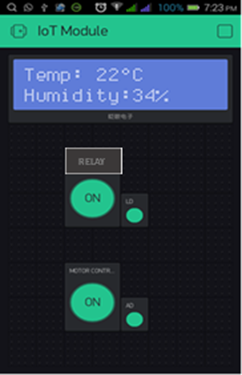 | Figure 3. Blynk App |
Four parameters (power consumption, range, cost and topology) were used to compare these wireless connectivity standards. Power consumption of each connectivity standard used was tested using a dc ammeter. The dc ammeter was connected in series with a 3.3 V source for the ZigBee and Bluetooth modules while a 5 V source was used for the Wi-Fi module. The power consumption test for each of the wireless connectivity standards used was taken in the sleep mode, awake mode, transmit mode, and receive mode. Figure 4 shows the setup for the test. Note that the wireless modules are powered separately. | Figure 4. Power consumption test setup |
For ZigBee, the range test interface of the XCTU (an app for ZigBee radio module configuration) was used to get the signal strength of the module. For both Bluetooth and Wi-Fi, the signal bar indicator was used in determining the range. The range of all the modules was tested over a 100 m distance. The cost comparison was done based on the current price of the wireless connectivity modules that were used for the research. The topology comparison was done based on available literature and device specifications [11-13].
4. Results
Data obtained during the power consumption, range, cost, and topology tests are presented. HC-05 Bluetooth module, XBee series 1 module and Arduino Yun are used as Bluetooth, ZigBee and Wi-Fi modules, respectively.
4.1. Power Consumption Test
Table 1 shows power consumption results while Figure 5 shows a graphical representation of power consumption comparison of the low energy wireless standards. Table 1. Power Consumption Test for Bluetooth, ZigBee and Wi-Fi
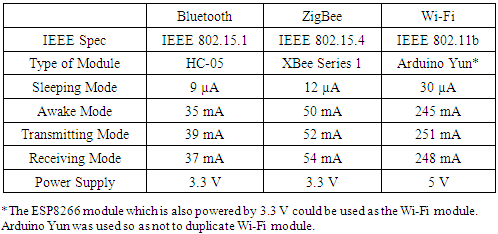 |
| |
|
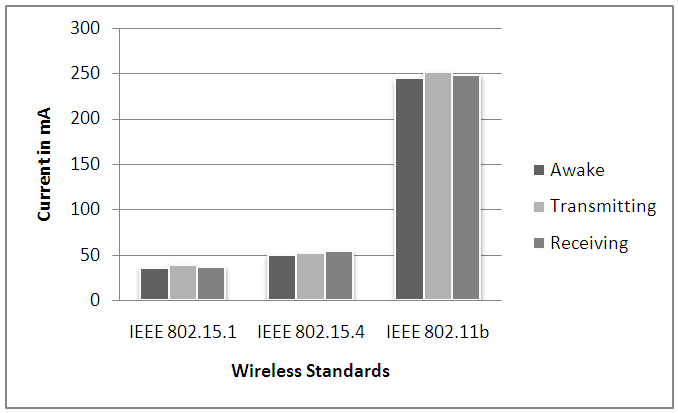 | Figure 5. Power consumption comparison |
4.2. Range Test
Range test results are as shown in Table 2. These tests were carried out in an open space. The signal strength over distance shown will definitely reduce with obstacles and noises.Table 2. Range Test for Bluetooth, ZigBee and Wi-Fi
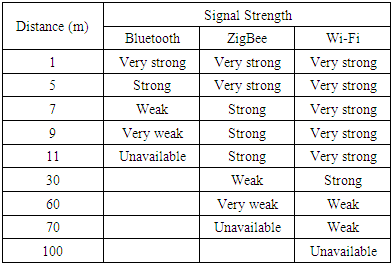 |
| |
|
4.3. Topology Comparison
Figure 6 shows the basic cell (or topology) of Bluetooth. A piconet consists of one master and at least one slave. A piconet supports a maximum of 7 slaves. Multiple masters can be used to extend this basic cell as shown in Figure 7 where we have a scatternet. | Figure 6. Piconet |
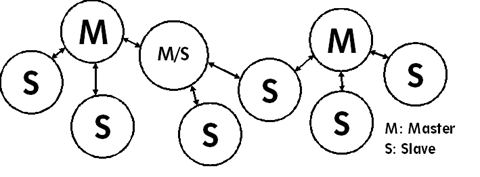 | Figure 7. Scatternet |
Figure 8 shows the basic topology of ZigBee (star topology). It consists of a coordinator and a single or multiple end devices. The star topology can also be extended to form mesh and cluster tree topologies as shown in Figures 9 and 10 respectively. Over 65,000 end devices can be connected in a single network.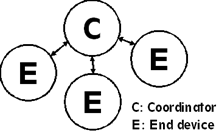 | Figure 8. Star topology |
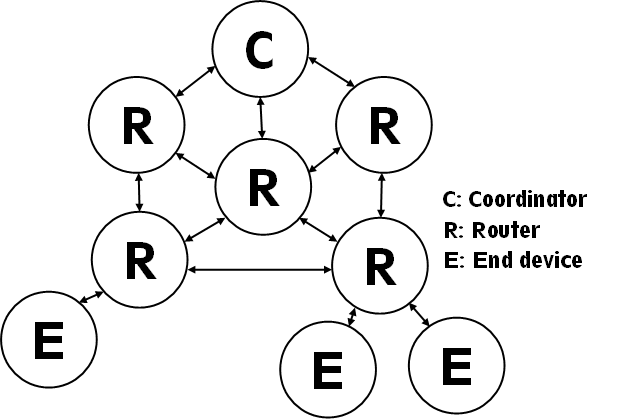 | Figure 9. Mesh Topology |
 | Figure 10. Cluster tree topology |
The basic cell for Wi-Fi network is known as Basic Service Set (BSS) as shown in Figure 11. It consists of an access point (AP) that enables communication among stations connected to it. Multiple APs can also be used to extend BSS resulting in Extended Service Set (ESS) as shown in Figure 12. Wi-Fi has the ability to participate in TCP/IP networks making it suitable for Internet connection. Up to 2,007 Wi-Fi stations can be connected in a Wi-Fi based network.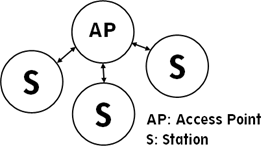 | Figure 11. Wi-Fi BSS topology |
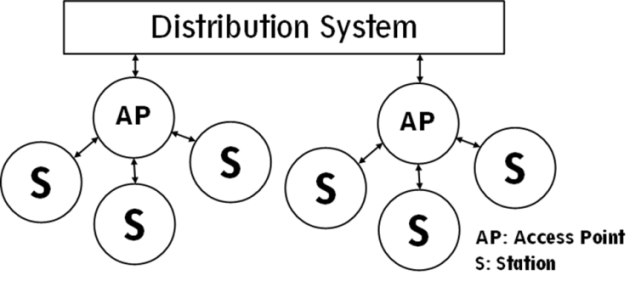 | Figure 12. Wi-Fi ESS topology |
4.4. Cost Comparison
Table 3 shows the cost of each wireless module used.Table 3. Cost of wireless standards
 |
| |
|
4.5. Discussion
From the foregoing, Bluetooth consumes the least energy among the connectivity modules used. Bluetooth and Wi-Fi consumes more power when transmitting than when receiving while ZigBee consumes more when receiving. Also, the power consumption of the 3 modules in the awake (but idle) mode is very close to their power consumption in the active (transmitting and receiving) mode. It is therefore advisable to keep the modules in sleep mode when they are not transmitting or receiving. Further experiments can be carried out to find out the relationship between distance and power consumed by these modules in IoT applications.The range of Bluetooth is very small relative to ZigBee and Wi-Fi. This implies that Bluetooth is only suitable for Personal Area Network (PAN) applications such as wearable devices. ZigBee and Wi-Fi allow more devices in a network than Bluetooth. Only ZigBee wireless protocol supports the mesh topology where end devices can communicate with themselves without having to go through a master or access point in the cases of Bluetooth and Wi-Fi respectively. This makes ZigBee the most suited for Wireless Sensor Networks (WSN) where only the coordinator(s) is connected to the Internet. Also, only Wi-Fi can connect directly to the Internet (others will require a protocol conversion gateway). Wi-Fi is therefore best suited for standalone nodes that require Internet access (for example, smart home nodes).HC-05 Bluetooth module is the cheapest of the modules considered (although ESP8266 Wi-Fi modules have in-built microcontroller which makes it programmable and therefore very cheap). Low cost applications therefore use Bluetooth and Wi-Fi. However, cost should be balanced power consumption, required range and the number and interactions between devices.
5. Conclusions
Due to the short range and low power consumption of Bluetooth, it will best suit application areas like wearable devices, smart health, body sensor network (BSN), smart vehicle application etc. ZigBee will best suit Industrial automation, robotics, WSN etc., because it can cover a wide range and allows a large number of devices to be connected in a single network. Wi-Fi is best suited for standalones (mostly in smart home applications) and mobile devices because it can implement TCP/IP and therefore the devices or nodes can connect to the Internet directly.
References
| [1] | L. Atzori, A. Iera, and G. Morabito, “The Internet of Things: A survey,” Computer Networks, vol. 54, no. 15, pp. 2787–2805, 2010. |
| [2] | K. Karimi and G. Atkinson, “What the Internet of Things (IoT) Needs to Become a Reality,” Freescale White Paper, p. 16, 2013. |
| [3] | A. Al-Fuqaha, M. Guizani, M. Mohammadi, M. Aledhari, and M. Ayyash, “Internet of Things: A Survey on Enabling Technologies, Protocols, and Applications,” IEEE Communication Survey & Tutorials, vol. 17, no. 4, pp. 2347–2376, 2015. |
| [4] | R. Khan, S. U. Khan, R. Zaheer, and S. Khan, “Future internet: The internet of things architecture, possible applications and key challenges,” in Proceedings - 10th International Conference on Frontiers of Information Technology, FIT 2012, 2012, pp. 257–260. |
| [5] | M. Wu, T. J. Lu, F. Y. Ling, J. Sun, and H. Y. Du, “Research on the architecture of Internet of Things,” in ICACTE 2010 - 2010 3rd International Conference on Advanced Computer Theory and Engineering, Proceedings, 2010, vol. 5. |
| [6] | T. Zachariah, N. Klugman, B. Campbell, J. Adkins, N. Jackson, and P. Dutta, “The Internet of Things Has a Gateway Problem,” HotMobile ’15 Proceedings of the 16th International Workshop on Mobile Computing Systems and Applications, pp. 27–32, 2015. |
| [7] | R. Petrolo, R. Morabito, V. Loscrì, and N. Mitton, “The design of the gateway for the Cloud of Things,” Annals of Telecommunications, 2016. |
| [8] | M. S. Mahmoud and A. A. H. Mohamad, “A Study of Efficient Power Consumption Wireless Communication Techniques/ Modules for Internet of Things (IoT) Applications,” Advances in Internet Things, vol. 6, no. 2, pp. 19–29, 2016. |
| [9] | J. S. Lee, Y. W. Su, and C. C. Shen, “A comparative study of wireless protocols: Bluetooth, UWB, ZigBee, and Wi-Fi,” in IECON Proceedings (Industrial Electronics Conference), 2007, pp. 46–51. |
| [10] | J. M. Tjensvold, “Comparison of the IEEE 802.11, 802.15.1, 802.15.4 and 802.15.6 wireless standards,” J. Antimicrob. Chemother., no. 1, pp. 1–7, 2007. |
| [11] | Digi International, “XBee ® /XBee-PRO ® RF Modules,” 2009. |
| [12] | ITead Studio, “Hc-05 Bluetooth Module,” Datasheet, pp. 1–13, 2010. |
| [13] | RABBIT, “An Introduction to Wi-Fi,” Digi Int. corp, USA, pp. 1–74, 2008. |















 Abstract
Abstract Reference
Reference Full-Text PDF
Full-Text PDF Full-text HTML
Full-text HTML

